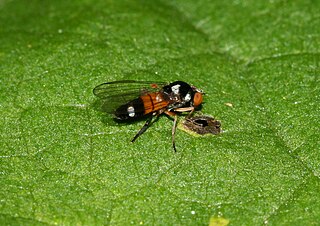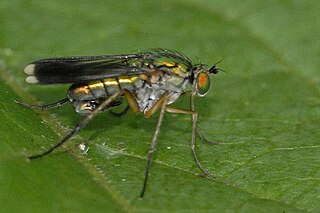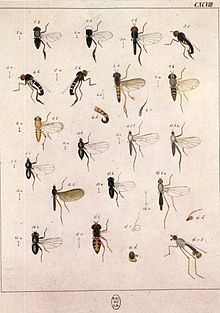
Nycteribiidae is a family of the true fly superfamily Hippoboscoidea are known as "bat flies", together with their close relatives the Streblidae. As the latter do not seem to be a monophyletic group, it is conceivable not to unite all bat flies in a single family.

Odiniidae is a small family of flies. There are only 58 described species but there are representatives in all the major biogeographic realms.

Rhagionidae or snipe flies are a small family of flies. They got their name from the similarity of their, often, prominent proboscis that looks like the beak of a snipe.

Platypezidae is a family of true flies of the superfamily Platypezoidea. The more than 250 species are found worldwide primarily in woodland habitats. A common name is flat-footed flies, but this is also used for the closely related Opetiidae which were included in the Platypezidae in former times.

Trachylepis is a skink genus in the subfamily Lygosominae found mainly in Africa. Its members were formerly included in the "wastebin taxon" Mabuya, and for some time in Euprepis. As defined today, Trachylepis contains the clade of Afro-Malagasy mabuyas. The genus also contains a species from the Brazilian island of Fernando de Noronha, T. atlantica, and may occur in mainland South America with Trachylepis tschudii and Trachylepis maculata, both poorly known and enigmatic. The ancestors of T. atlantica are believed to have rafted across the Atlantic from Africa during the last 9 million years.

Dolichopus is a large cosmopolitan genus of flies in the family Dolichopodidae. Adults are small flies, typically less than 8 mm in length. Nearly all species are metallic greenish-blue to greenish-bronze. It is the largest genus of Dolichopodidae with more than 600 species worldwide.

Volucella is a genus of large, broad-bodied, dramatic hover-flies. They have distinctive plumose aristae and the face is extended downward. They are strongly migratory and males are often territorial. Adults feed on nectar of flowers and are often seen sunning on leaves. The larvae of most species live in nests of bumblebees and social wasps, where they are detritivores and larval predators.

Merodon is a large genus of bee-like hoverflies. The majority of the species are centered on the Mediterranean and it is the second largest hoverfly genus in Europe with more than 50 European species. It is distributed over the Palaearctic and Afrotropical realms, with most European species occurring in Southern and Eastern Europe. The centre of distribution of this genus appears to be Turkey, where about 65 species have been recorded. Some species occur in Africa and the middle East, as far as Pakistan. Given the rate at which new species have been recorded over the past decades, the worldwide number of species could exceed 200. The larvae feed on the bulbs or rhizomes of monocotyledons.
Eophyllophila is a genus of flies in the family Tachinidae.

Phyllomya is a genus of flies in the family Tachinidae.

Dorycera is a genus of picture-winged flies in the family Ulidiidae.

Medetera is a large genus of flies in the family Dolichopodidae.

Sphegina is a genus of small, slender hoverflies associated with woodlands. They are widespread throughout Eurasia and North America.

Pipiza is a genus Hoverflies, from the family Syrphidae, in the order Diptera. Most are dark hoverflies.

Bolitophila is the sole living genus in the Bolitophilidae, a family of Diptera in the superfamily Sciaroidea, with around 40 Palaearctic and about 20 Nearctic species, and three species from the Oriental region (Taiwan). They are small (6–9 mm.)

Callomyia is a genus of flies in the family Platypezidae. Some species can be found in Belgium.

Sepedon is a genus of flies in the family Sciomyzidae, the marsh flies or snail-killing flies.

Hydrophorinae is a subfamily of flies in the family Dolichopodidae. According to Germann et al. (2011), the subfamily is polyphyletic.

Poecilobothrus is a genus of flies in the family Dolichopodidae.
Callomyia corvina is a species of flat-footed flies.


















